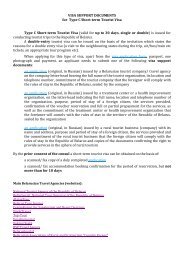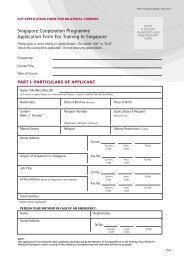Human Development Report 2013 - UNDP
Human Development Report 2013 - UNDP
Human Development Report 2013 - UNDP
Create successful ePaper yourself
Turn your PDF publications into a flip-book with our unique Google optimized e-Paper software.
3.6 India’s Supreme Court issues a progressive verdict mandating seats fordisadvantaged children in private schools 793.7 Bangladesh makes dramatic advances in child survival 813.8 Strengthening social protection in Turkey 833.9 Conditional cash transfer programmes and Mexico’s Oportunidades 843.10 Why New York City looked South for antipoverty policy advice 854.1 Why population prospects will likely differ in the Republic of Korea and India 884.2 China and Ghana: who benefits from the demographic dividend? 1005.1 The shifting line between public and private in transportation 1065.2 A world parliament for global democracy? 1125.3 Regional finance in Asia: Chiang Mai Initiative Multilateralization and theAsian <strong>Development</strong> Bank 1145.4 CAF: a Latin American development bank 115FIGURES1 Acceleration of growth on the HDI 122 More than 40 countries of the South had greater gains on the HDI between1990 and 2012 than would have been predicted from their previousperformance on the HDI 123 Brazil, China and India combined are projected to account for 40% of globaloutput by 2050, up from 10% in 1950 134 The middle class in the South is projected to continue to grow 145 The exponential rise in Internet use in the South has been most notable overthe past decade 156 At least 15 developing countries have substantial trading relationships withmore than 100 trade partners as both exporters and importers 167 Official foreign exchange reserves by country group 181.1 Income per capita is rising to varying degrees in all four HDI groups 261.2 Sub-Saharan Africa has sustained income growth over the last decade 261.3 The lower the HDI value, the larger the gap between income poverty andmultidimensional poverty 291.4 There is notable variation among countries in the gap between incomepoverty and multidimensional poverty 301.5 Losses due to inequality in HDI and its components 311.6 Most regions show declining inequality in health and education and risinginequality in income 321.7 Few countries show both the high HDI and low ecological footprint requiredfor sustainable human development 351.8 <strong>Development</strong> is not always accompanied by a rise in military spending 402.1 As a share of world merchandise trade, South–South trade more than tripledover 1980–2011, while North–North trade declined 462.2 Foreign direct investment flows to and from the South have veered sharplyupward since the 1990s 472.3 Between 2000 and 2010, Internet use grew more than 30% a year in around60 developing countries 502.4 Export earnings per capita and human development are highly correlated 522.5 Current foreign direct investment is positively associated with achievementsin health and education in previous years 532.6 Emerging market economies have amassed large foreign exchange reservessince 1995 583.1 Some countries have performed well on both the nonincome and the incomedimensions of the HDI 633.2 Current HDI values and previous public expenditures are positively correlated . . . 713.3 . . . as are current child survival and previous public expenditure on health 714.1 Under the fast track scenario, education outcomes are enhanced 924.2 In most countries, employment opportunities have not kept pace witheducational attainment 934.3 At each HDI level, some countries have greater carbon productivity than others 944.4 Different environmental scenarios have different impacts on extreme poverty 964.5 Education policies can alter dependency ratios 984.6 Populations are ageing more rapidly in developing countries 1014.7 <strong>Human</strong> development prospects for 2050 are greater under the acceleratedprogress scenario, especially for low HDI countries 1014.8 <strong>Human</strong> development outcomes through 2050 improve more under theaccelerated progress scenario 1024.9 Advances in GDP per capita through 2050 are especially strong under theaccelerated progress scenario 1035.1 Under the accelerated progress scenario, the largest projected increases inthe <strong>Human</strong> <strong>Development</strong> Index are in Sub-Saharan Africa and South Asia 1185.2 Allocating a small fraction of the international reserves of the nine G20countries of the South could provide substantial additional resources forpublic investment in infrastructure in Sub-Saharan Africa and South Asia 118MAPS1.1 There is a small negative connotation between homicide rates and HDI values 392.1 Thailand’s export expansion, 1995–2011 45TABLES1.1 HDI and components, by region and HDI group, 2012 251.2 Top five countries that rank better on the HDI than on gross national incomeper capita in 2012 271.3 Inequality and satisfaction with freedom of choice and community 382.1 Least developed countries’ trade with China, 2000–2001 and 2010–2011 462.2 Different models of development partnerships 563.1 Selected developing countries that registered large reductions in HDI shortfallor high rates of growth in gross national income per capita, 1990–2012 643.2 Share of world exports of goods and services of high achievers in humandevelopment, 1985–1990 and 2005–2010 754.1 Under-five mortality rate and total fertility rate by mother’s education level 894.2 Projected number of deaths of children under age 5, by education scenario,2010–2015, 2025–2030 and 2045–2050 904.3 Population in extreme poverty under the environmental disaster scenario,by region, 2010–2050 964.4 Trends in dependency ratios, selected countries, 1970–2050 994.5 Number of people in extreme poverty by region and selected countries, basecase and accelerated progress scenarios, 2010–2050 103Contents | ix
















